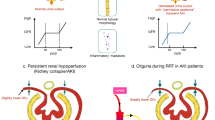Abstract
Acute kidney injury (AKI) is a serious complication of pediatric cardiac surgery, with high morbidity and mortality. We aimed to evaluate the perioperative risk factors for AKI, and the validity of novel diagnostic urinary biomarkers after pediatric cardiac surgery. We analyzed 103 consecutive pediatric patients (≤ 18 years old), who underwent cardiac surgery. AKI was defined by ≥ 50% increase in serum creatinine levels from baseline. Urinary liver-type fatty acid binding protein (L-FABP) and neutrophil gelatinase-associated lipocalin (NGAL) were measured postoperatively at the intensive care unit (ICU) admission, subsequently at 4, 12, and 24 h. Areas under the receiver-operating characteristic curves (AUC) were calculated at each assessment time. AKI had developed in 47 patients (45.6%) by the second postoperative day. Univentricular status, aortic cross-clamping time, and intraoperative fluid balance were independently associated with AKI (p = 0.02, 0.01 and 0.01, respectively). Urinary L-FABP and NGAL were significantly higher in the AKI group at each point (p < 0.05). The predictive abilities of both biomarkers (AUC = 0.78–0.90) at ICU admission and 4 h after were especially high. The patients with L-FABP greater than the cutoff value at ICU admission and 4 h after ICU admission had significantly longer intubation and hospitalization periods (p < 0.05). Those with elevated NGAL levels at admission, and 4 h and 24 h after ICU admission, had significantly longer intubation, ICU stay, and hospitalization (p < 0.05). L-FABP and NGAL can be useful biomarkers for detecting early AKI after pediatric cardiac surgery and predicting adverse clinical outcomes.



Similar content being viewed by others
References
Aydin SI, Seiden HS, Blaufox AD, Parnell VA, Choudhury T, Punnoose A, Schneider J (2012) Acute kidney injury after surgery for congenital heart disease. Ann Thorac Surg 94:1589–1595. https://doi.org/10.1016/j.athoracsur.2012.06.050
Li S, Krawczeski CD, Zappitelli M, Devarajan P, Thiessen-Philbrook H, Coca SG, Kim RW, Parikh CR; TRIBE-AKI Consortium (2011) Incidence, risk factors, and outcomes of acute kidney injury after pediatric cardiac surgery: a prospective multicenter study. Crit Care Med 39:1493–1499. https://doi.org/10.1097/CCM.0b013e31821201d3
Zappitelli M, Bernier PL, Saczkowski RS, Tchervenkov CI, Gottesman R, Dancea A, Hyder A, Alkandari O (2009) A small postoperative rise in serum creatinine predicts acute kidney injury in children undergoing cardiac surgery. Kidney Int 76:885–892. https://doi.org/10.1038/ki.2009.270
Morgan CJ, Zappitelli M, Robertson CM, Alton GY, Sauve RS, Joffe AR, Ross DB, Rebeyka IM; Western Canadian Complex Pediatric Therapies Follow-Up Group (2013) Risk factors for and outcomes of acute kidney injury in neonates undergoing complex cardiac surgery. J Pediatr 162:120–127. https://doi.org/10.1016/j.jpeds.2012.06.054
Toth R, Breuer T, Cserep Z, Lex D, Fazekas L, Sapi E, Szatmari A, Gai J, Szekely A (2012) Acute kidney injury is associated with higher morbidity and resource utilization in pediatric patients undergoing heart surgery. Ann Thorac Surg 93:1984–1990. https://doi.org/10.1016/j.athoracsur.2011.10.046
Taylor ML, Carmona F, Thiagarajan RR, Westgate L, Ferguson MA, del Nido PJ, Rajagopal SK (2013) Mild postoperative acute kidney injury and outcomes after surgery for congenital heart disease. J Thorac Cardiovasc Surg 146:146–152. https://doi.org/10.1016/j.jtcvs.2012.09.008
Lee SH, Kim SJ, Kim HJ, Son JS, Lee R, Yoon TG (2017) Acute kidney injury following cardiopulmonary bypass in children—risk factors and outcomes. Circ J 81:1522–1527. https://doi.org/10.1253/circj.CJ-17-0075
Dong L, Ma Q, Bennett M, Devarajan P (2017) Urinary biomarkers of cell cycle arrest are delayed predictors of acute kidney injury after pediatric cardiopulmonary bypass. Pediatr Nephrol 32:2351–2360. https://doi.org/10.1007/s00467-017-3748-7
Krawczeski CD, Goldstein SL, Woo JG, Wang Y, Piyaphanee N, Ma Q, Bennett M, Devarajan P (2011) Temporal relationship and predictive value of urinary acute kidney injury biomarkers after pediatric cardiopulmonary bypass. J Am Coll Cardiol 58:2301–2309. https://doi.org/10.1016/j.jacc.2011.08.017
Lex DJ, Toth R, Cserep Z, Alexander SI, Breuer T, Sapi E, Szatmari A, Szekely E, Gal J, Szekely A (2014) A comparison of the systems for the identification of postoperative acute kidney injury in pediatric cardiac patients. Ann Thorac Surg 97:202–210. https://doi.org/10.1016/j.athoracsur.2013.09.014
Selewski DT, Cornell TT, Heung M, Troost JP, Ehrmann BJ, Lombel RM, Blatt NB, Luckritz HS, Gajarski R, Kershaw DB, Shanley TP, Gipson DS (2014) Validation of the KDIGO acute kidney injury criteria in a pediatric critical care population. Intensive Care Med 40:1481–1488. https://doi.org/10.1007/s00134-014-3391-8
Blinder JJ, Goldstein SL, Lee VV, Baycroft A, Fraser CD, Nelson D, Jefferies JL (2012) Congenital heart surgery in infants: effects of acute kidney injury on outcomes. J Thorac Cardiovasc Surg 143:368–374. https://doi.org/10.1016/j.jtcvs.2011.06.021
Maatman RG, van de Westerlo EM, van Kuppevelt TH, Veerkamp JH (1992) Molecular identification of the liver- and the heart-type fatty acid-binding proteins in human and rat kidney. Use of the reverse transcriptase polymerase chain reaction. Biochem J 288:285–290
Maatman RG, Van Kuppevelt TH, Veerkamp JH (1991) Two types of fatty acid-binding protein in human kidney. Isolation, characterization and localization. Biochem J 273:759–766. https://doi.org/10.1042/bj2730759
Portilla D, Dent C, Sugaya T, Nagothu KK, Kundi I, Moore P, Noiri E, Devarajan P (2008) Liver fatty acid-binding protein as a biomarker of acute kidney injury after cardiac surgery. Kidney Int 73:465–472
Jefferies JL, Devarajan P (2016) Early detection of acute kidney injury after pediatric cardiac surgery. Prog Pediatr Cardiol 41:9–16
Ivanišević I, Peco-Antić A, Vuličević I, Hercog D, Milovanovic V, Kotur-Stevuljevic J, Stefanovic A, Kocev N (2013) L-FABP can be an early marker of acute kidney injury in children. Pediatr Nephrol 28:963–969. https://doi.org/10.1007/s00467-013-2421-z
Funding
None declared.
Author information
Authors and Affiliations
Corresponding author
Ethics declarations
Conflict of interest
The authors declare that they have no competing interests.
Additional information
Publisher's Note
Springer Nature remains neutral with regard to jurisdictional claims in published maps and institutional affiliations.
Rights and permissions
About this article
Cite this article
Yoneyama, F., Okamura, T., Takigiku, K. et al. Novel Urinary Biomarkers for Acute Kidney Injury and Prediction of Clinical Outcomes After Pediatric Cardiac Surgery. Pediatr Cardiol 41, 695–702 (2020). https://doi.org/10.1007/s00246-019-02280-3
Received:
Accepted:
Published:
Issue Date:
DOI: https://doi.org/10.1007/s00246-019-02280-3




